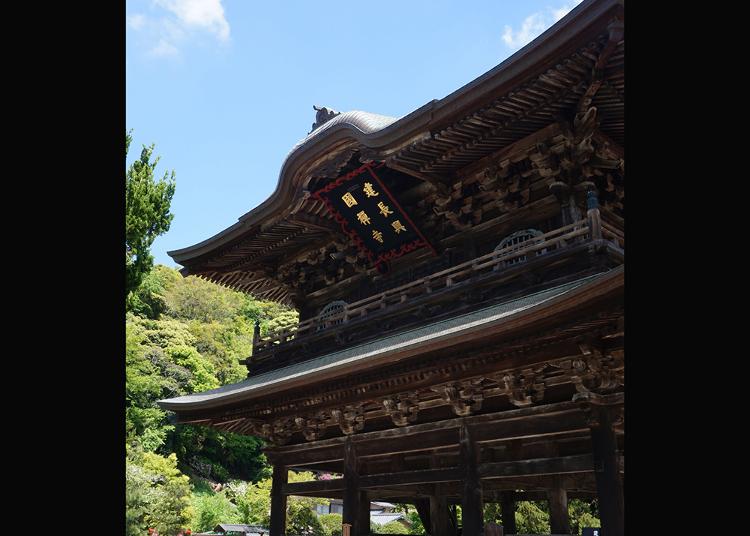
Nestled amidst the serene landscapes of Japan's Kanagawa Prefecture lies the historic city of Kamakura, a place where ancient traditions and natural beauty harmoniously coexist. With its rich cultural heritage and spiritual significance, Kamakura has been a revered destination for pilgrims, seekers of tranquility, and curious travelers alike. At the heart of this city's allure are its temples, each with its unique stories, architecture, and a profound sense of spirituality that transcends time.
In this article, we invite you on a virtual pilgrimage to some of the most renowned and captivating temples that grace Kamakura's landscape. From the tranquil gardens of Kencho-ji to the awe-inspiring presence of the Great Buddha at Kotoku-in, we will guide you through a spiritual journey that reveals the soul of Kamakura.
1. Hase-dera

Hasedera, also known as the Hasedera Temple, boasts a rich and ancient history, tracing its roots back to the distant year of 736, a period long preceding the famed Kamakura era (1192–1333). At the heart of Hasedera lies its principal icon, an imposing eleven-faced Kan'non Bodhisattva, proudly standing as one of Japan's most colossal wooden statues, soaring to an impressive height of 9.18 meters.
Ascending to the upper precinct of Hasedera, you'll encounter the Kan'non-do Hall, a sacred sanctuary housing the revered eleven-faced Kannon Bosatsu, flanked by other significant halls. Moreover, an observation tower graces this elevated space, offering an unparalleled vantage point from which to savor panoramic vistas of both the ocean and the city, crafting one of Kamakura's most exquisite scenic gems.
Adding to Hasedera's allure is its circuit garden, inviting visitors to meander through its pathways and immerse themselves in the natural surroundings. Regardless of the season, this enchanting garden boasts an ever-changing tapestry of beauty, with blooming trees such as magnolias, somei-yoshino cherry trees, hydrangeas, fragrant olives, and camellias throughout the year. It's no exaggeration to dub this garden Kamakura's "Saiho-gokuraku-jodo" — the Pure Land of Highest Happiness.
For those seeking a deeper connection with Buddhism, Hasedera extends an invitation to partake in sutra copying or explore the Kan'non museum located on the premises, providing an educational and enlightening experience.
-

-
Address
3-11-2 Hasaya, Kamakura, Kanagawa Prefecture, 248-0016
View Map -
Nearest Station
Hase Station (Enoshima Electric Railway Line)
5 minutes on foot
- Phone Number 0467-22-6300
-
Address
3-11-2 Hasaya, Kamakura, Kanagawa Prefecture, 248-0016
2. The Great Buddha and Kotoku-in

Kotoku-in, a distinguished Buddhist temple belonging to the jodo-shu sect, traces its spiritual lineage back to the revered Priest Honen. The focal point of Kotoku-in's profound reverence is the awe-inspiring copper image of Amidanyorai, a masterpiece that has earned the endearing nickname "Buddha sitting in a roofless house." This exceptional creation stands as a cherished national treasure of Japan, with a stature that reaches an astonishing 11.3 meters and a weight that tips the scales at a staggering 121 tonnes. Remarkably, the statue remains in a state that is remarkably close to its original form, representing a priceless artifact in the annals of Japanese Buddhist art history.
The genesis of the Great Buddha, as it is colloquially known, dates back to the year 1252. However, the historical records of that time are fraught with gaps, shrouding the identity of its creator in an enduring enigma. Even after seven and a half centuries since its inception, the Great Buddha continues to exert a magnetic pull, drawing devout Buddhists from all sects, both domestic and international, to its hallowed presence. It stands not only as an icon of Japanese Buddhism but also as a symbol of enduring spiritual significance.
Visitors to this sacred site are granted a rare glimpse into the inner sanctum of the statue, affording them the opportunity to witness the intricate casting techniques that were employed during its creation, showcasing the advanced craftsmanship of its era.
-

-
Address
4-2-28, Hase, Kamakura-shi, Kanagawa, 248-0016
View Map -
Nearest Station
Hase Station (Enoshima Electric Railway Line)
7 minutes on foot
- Phone Number 0467-22-0703
-
Address
4-2-28, Hase, Kamakura-shi, Kanagawa, 248-0016
3. Kencho-ji
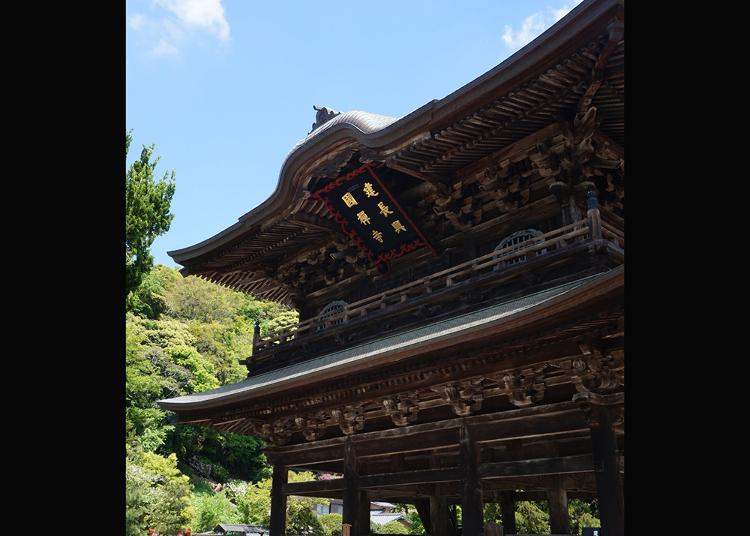
Kencho-ji Temple stands as a timeless testament to Japan's spiritual heritage, enriched by centuries of history. Holding the esteemed position of being the foremost among the Kamakura Gozan temples, Kencho-ji also serves as the head temple of the Kencho-ji Temple school within the Rinzai sect of Buddhism. Its origins harken back to a significant chapter in Japan's past when, in 1253, Hojo Tokiyori, a regent of the era, extended an invitation to a distinguished high priest from China's Song Dynasty. The purpose was twofold: to establish a familial temple and to commemorate the nation's ascendance.
Kencho-ji's legacy is steeped in devotion and discipline, as it is said that over a thousand aspiring monks once practiced rigorous asceticism within its hallowed training hall. At the heart of Kencho-ji's architectural magnificence stands the Sanmon, a trio of gates erected in 1775. Originally thatched, these gates now gleam with copper, a testament to the grand renovations undertaken in the early 2000s, restoring the temple to its pristine splendor from centuries past.
Venturing through the stately Sanmon gates, visitors are greeted by a tapestry of remarkable Buddhist edifices. The Butsuden, or Buddhist Hall, reverently enshrines the Jizo-Bosatsu, the central object of devotion. The Hatto, or Dharma Hall, is home to the statue of the thousand-armed Kannon, an embodiment of compassion. Meanwhile, the Hojo, also known as Ryuo-den, houses the revered statue of Hokan Shaka Nyorai.
Kencho-ji Temple's significance extends beyond its spiritual heritage, boasting three national treasures, including the statue of Daikaku Zenji, the temple's founder, and three important cultural assets, notably the seated statue of Hojo Tokiyori. As such, the temple stands as a veritable treasure trove of both religious and cultural history.
-

-
Address
8, Yamanouchi, Kamakura-shi, Kanagawa, 247-8525
View Map -
Nearest Station
Kita-Kamakura Station (JR Yokosuka Line / JR Shonan Shinjuku Line)
- Phone Number 0467-22-0981
-
Address
8, Yamanouchi, Kamakura-shi, Kanagawa, 247-8525
4. Engaku-ji
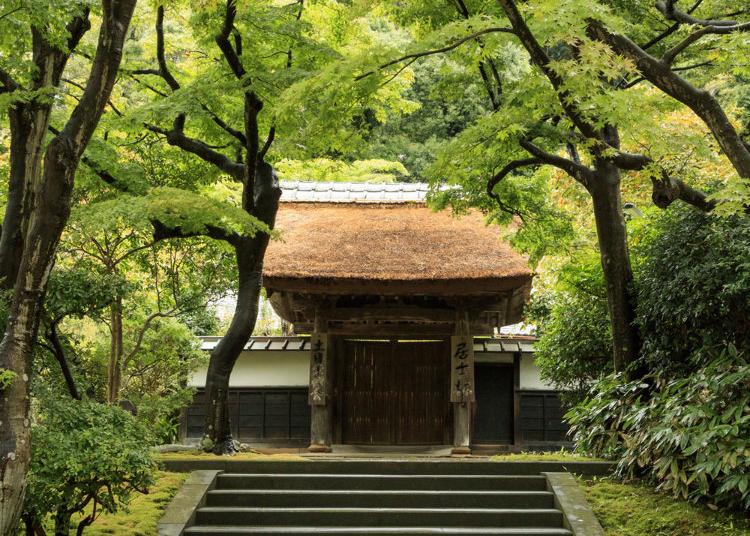
Enkaku-ji Temple emerges as a tranquil sanctuary nestled alongside a valley sculpted by the relentless forces of erosion, where once a hill stood tall. This sacred institution stands as the spiritual beacon and the head temple of the Enkaku-ji Sect, an esteemed branch of the Rinzai School of Zen Buddhism. In the annals of history, it was the visionary Tokimune Hojo, serving as regent during 1282, who laid the foundation stones of this temple, motivated by a profound vision for his nation, the propagation of Zen Buddhism, and the solemn remembrance of the countless lives lost in the wars of that era. Significantly, his intention transcended the boundaries of friend and foe, emphasizing unity in mourning.
The architectural layout of Enkaku-ji Temple harmoniously utilizes the contours of the terrain, revealing a succession of halls as one ascends the temple grounds, creating a truly magnificent spectacle. Greeting visitors at the entrance is the imposing San-mon gate, a guardian to the temple's sacred precincts. Beyond this threshold lies the Buddhist hall, where the principal object of devotion resides, a space that comes alive with morning zazen meditation and various other spiritual gatherings.
Further exploration of the temple's grounds leads to the Koji-rin training hall, a crucible for Zen practitioners to refine their spiritual path, and the reliquary hall, a distinguished National Treasure, believed to safeguard relics of the Buddha, including sacred teeth.
Enkaku-ji Temple offers a captivating array of historical treasures, including the temple bell, a towering National Treasure and the largest of its kind in the Kanto region, standing tall at 259.5 centimeters.
-

-
Address
409, Yamanouchi, Kamakura-shi, Kanagawa, 247-0062
View Map -
Nearest Station
Kita-Kamakura Station (JR Yokosuka Line / JR Shonan Shinjuku Line)
1 minute on foot
- Phone Number 0467-22-0478
-
Address
409, Yamanouchi, Kamakura-shi, Kanagawa, 247-0062
5. Sugimoto-dera
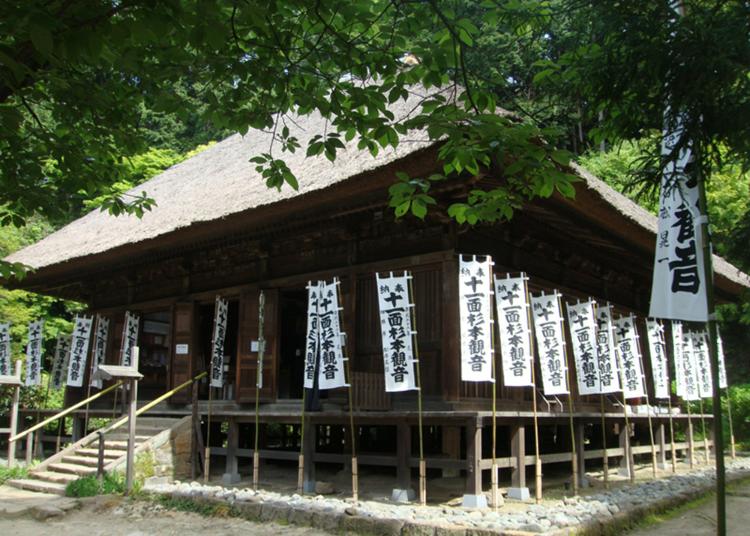
Sugimoto-dera Temple, a timeless bastion of spirituality, proudly holds the title of being the oldest temple in the revered Kamakura region. At its heart, it reveres the three figures of the eleven-faced Kan'non Avalokiteśvara, serving as the principal object of devotion. This sacred sanctuary holds a pivotal role as the inaugural stop on the "Kamakura Thirty-Three Kan'non Pilgrimage of Bando," a revered journey of spiritual significance.
Founded in the year 734, Sugimoto-dera carries with it the legacy of High Priest Gyoki, who undertook its creation at the behest of Empress Komyo. An enchanting legend shrouds the temple's origins, narrating that the primary icon of worship found refuge beneath the protective canopy of a cedar tree within the temple's sacred precincts during the tumultuous Kamakura era (1192 – 1333). Hence, the temple has garnered the name Sugi-moto, which translates to "under a cedar tree."
A cherished annual tradition, the Gomadaki ritual, takes place on January 18th, during the celebration of hatsu Kan'non, marking the first Kannon ceremony. This event serves to commemorate and unveil the temple's revered statues.
Sugimoto-dera's architectural marvels include the Hondo, or main hall, and the Nio-mon Gate, both adorned with rare thatched roofs, a distinctive feature in temple architecture. The temple grounds are a botanical delight, boasting an ever-changing landscape throughout the seasons. Cherry blossoms grace the temple in spring, hydrangeas flourish in summer, maple trees adorn it in autumn, and sasanqua camellias bloom in winter. Additionally, the grounds are home to a variety of lovely wildflowers, such as alpine gesneriad and bellflowers.
-

-
Address
903, Nikaido, Kamakura-shi, Kanagawa, 248-0002
View Map -
Nearest Station
Kamakura Station (JR Yokosuka Line / JR Shonan Shinjuku Line / Enoshima Electric Railway Line)
- Phone Number 0467-22-3463
-
Address
903, Nikaido, Kamakura-shi, Kanagawa, 248-0002
6. Zuisen-ji
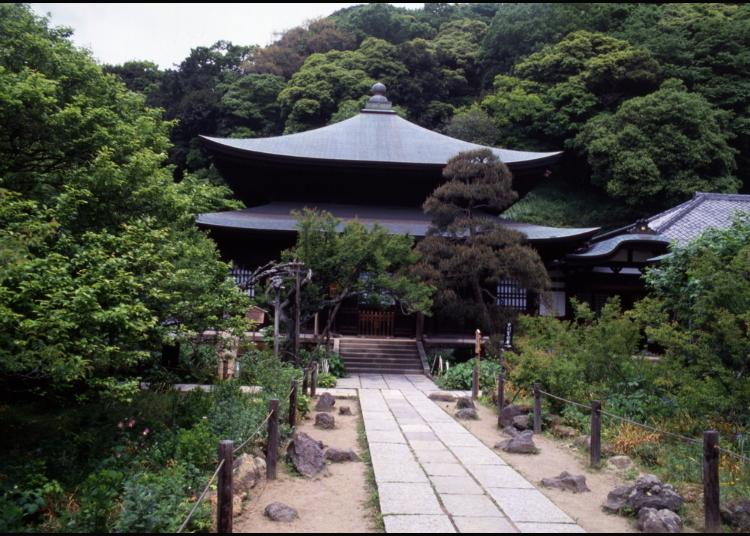
Zuisenji Temple stands as a venerable testament to Zen Buddhism's profound heritage. Established in 1327 by the illustrious Muso Soseki, it occupies a prestigious position among the Kanto-jissatsu, the esteemed "Ten Temples of Kanto," and rests just one tier below the revered Kamakura-gozan, the "Five Temples of Kamakura."
Muso Kokushi, also known as Muso Soseki, was a distinguished Zen Buddhist priest of the Rinzai school, whose spiritual influence spanned the Kamakura to Nanboku-cho Periods. He held the exalted position of high priest at five distinct temples consecutively, including the famed Engaku-ji. Beyond his spiritual pursuits, Muso Soseki was renowned for his mastery in garden design, leaving an indelible mark on the landscape of Zen philosophy. Among his creations is the celebrated garden at Saiho-ji, also known as Koke-dera, in Kyoto, a UNESCO World Heritage Site. Within Zuisenji's sacred precincts, a testament to his genius endures in the form of yet another garden, a Zen masterpiece. These Zen Buddhist gardens, born from the artful sculpting of bedrock and the orchestration of water, beckon contemplation and tranquility.
Zuisenji Temple further earns its reputation as "Kamakura's flower temple," celebrating the changing seasons with an array of botanical marvels. Early spring welcomes the delicate bloom of ume, or plum blossoms, while summer showcases the serene elegance of lotus blooms. Winter brings the fragrant narcissus into focus, and late autumn's splendor unfolds as the leaves embrace their vibrant hues. An extraordinary spectacle unfolds when the trees within the temple precincts and the surrounding mountains simultaneously erupt in a symphony of colors, a sight celebrated by the names Momijigayatsu and Kinpeisan.
-

-
Address
710, Nikaido, Kamakura-shi, Kanagawa, 248-0002
View Map -
Nearest Station
Kamakura Station (JR Yokosuka Line / JR Shonan Shinjuku Line / Enoshima Electric Railway Line)
- Phone Number 0467-22-1191
-
Address
710, Nikaido, Kamakura-shi, Kanagawa, 248-0002
*Prices and options mentioned are subject to change.
*Unless stated otherwise, all prices include tax.
Popular Tours & Activitiess
Recommended places for you
-

2025 Japan Autumn Color Report: Tokyo's Ginkgo Trees Starting to Glow
by: Timothy Sullivan
-

Black Friday 2025: These Are THE Japan Travel & Shopping Deals to Check Out
-

LaLaport TOKYO-BAY North Building Now Open: Shop, Dine & Enjoy Events at LaLa arena, Just 2 Stops from Disney
by: Wemmy Chau
-

Get Ready to Catch 'Em All! First Ever Permanent Outdoor Pokémon Park Opening Near Tokyo!
-

See Asakusa and Tokyo Skytree® in a New Light at the "Také Akari" Festival (Winter 2025-2026)
by: Guest Contributor
-

Don't Miss Out! The One Thing You Must Do Before Shopping at Mitsui Shopping Park LaLaport: Get Your Max 10% OFF Coupon Book
Inspiration for Accommodations
-

Enjoy Mt. Fuji from the Comfort of Your Room! Recommended Ryokan with Mt. Fuji View
-

Stay Near the Cherry Blossoms! Hotels for Cherry Blossom Viewing in Tokyo
-

Family-Friendly Hotels with Free Shuttle to Disneyland: Convenient Access for a Magical Stay
-

Top Ranked Hakone Hotels with Mt. Fuji View: Enjoy Stunning Scenery from Your Private Space
-

Convenient Tokyo Hotels with Airport Shuttle: Ideal for Families and Heavy Luggage
-

Stunning Tokyo Tower View Hotels: Enjoy Spectacular Scenery from Your Private Space
-

Convenient Asakusa Hotels with Kitchens: Ideal for Extended Family Visits
-

Experience Luxury: Hakone's 10 Best Five-Star Accommodations
-

Enjoy Mt. Fuji Autumn Leaves! Top Hotels Near the Popular Autumn Leaves Corridor
-

Experience Hakone Fall Foliage from Your Room with Stunning Views
-

Tokyo Tsukiji|Tsukiji Area Map & Sightseeing Information
-

One-Day Itinerary Idea: Tour Tokyo's Historic Asakusa Neighborhood
by: Mae Kakizaki
-

Awesome Things to Do In Japan: Most Popular Temples in Asakusa! (March 2020 Ranking)
-

Exploring Tokyo Station: 11 Must-Visit Spots Around the Heart of Tokyo
-

Essential Tokyo: The Complete Guide to Ikebukuro Station
-

Graves of the 47 Ronin & More! 10 Must-See Famous Temples in Tokyo
- #best ramen tokyo
- #what to buy in ameyoko
- #what to bring to japan
- #new years in tokyo
- #best izakaya shinjuku
- #things to do tokyo
- #japanese nail trends
- #what to do in odaiba
- #onsen tattoo friendly tokyo
- #daiso
- #best sushi ginza
- #japanese convenience store snacks
- #best yakiniku shibuya
- #japanese fashion culture
- #best japanese soft drinks




















